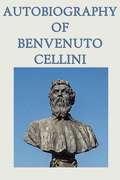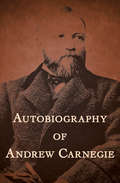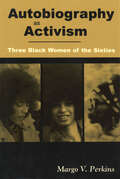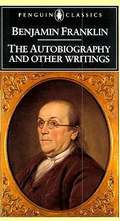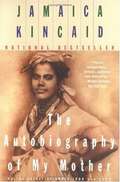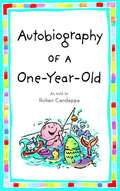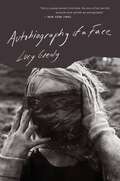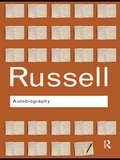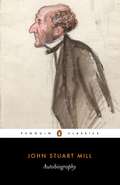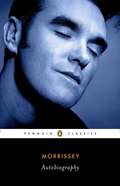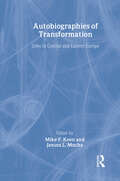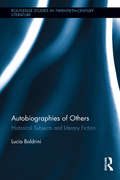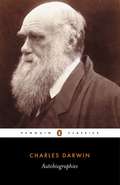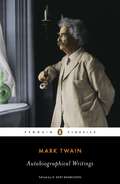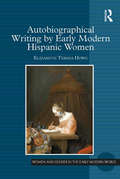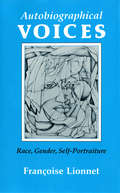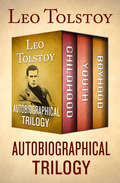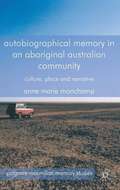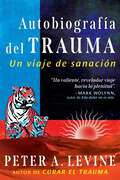- Table View
- List View
Autobiography of Benvenuto Cellini
by Benvenuto CelliniBenvenuto Cellini was a celebrated Renaissance sculptor and goldsmith; a passionate craftsman who was admired and resented by the most powerful political and artistic personalities in sixteenth-century Florence, Rome and Paris. He was also a murderer and a braggart, a shameless adventurer who at different times experienced both papal persecution and imprisonment, and the adulation of the royal court. Inn-keepers and prostitutes, kings and cardinals, artists and soldiers rub shoulders in the pages of his notorious autobiography: a vivid portrait of the manners and morals of both the rulers of the day and of their subjects. Written with supreme powers of invective and an irrepressible sense of humour, this is an unrivalled glimpse into the palaces and prisons of the Italy of Michelangelo and the Medici.
Autobiography of Andrew Carnegie: Large Print
by Andrew CarnegieA critically acclaimed autobiography by one of America's greatest philanthropists Scottish immigrant Andrew Carnegie worked his way up from bobbin boy to telegraph operator to railroad man, learning key lessons along the way that would eventually lead to his unparalleled success in the steel business. Documenting a world of tariffs, insider deals, and Wall Street sharks, The Autobiography of Andrew Carnegie opens a window into the great industrialist's decision-making process. His insights on education, business, and the necessity of giving back for the common good set an inspirational example for aspiring executives and provide a fitting testament to the power of the American dream. This ebook has been professionally proofread to ensure accuracy and readability on all devices.
Autobiography as Activism: Three Black Women of the Sixties
by Margo V. PerkinsAngela Davis, Assata Shakur (a.k.a. JoAnne Chesimard), and Elaine Brown are the only women activists of the Black Power movement who have published book-length autobiographies. In bearing witness to that era, these militant newsmakers wrote in part to educate and to mobilize their anticipated readers. In this way, Davis's Angela Davis: An Autobiography (1974), Shakur's Assata (1987), and Brown's A Taste of Power: A Black Woman's Story (1992) can all be read as extensions of the writers' political activism during the 1960s. Margo V. Perkins's critical analysis of their books is less a history of the movement (or of women's involvement in it) than an exploration of the politics of storytelling for activists who choose to write their lives. Perkins examines how activists use autobiography to connect their lives to those of other activists across historical periods, to emphasize the link between the personal and the political, and to construct an alternative history that challenges dominant or conventional ways of knowing. The histories constructed by these three women call attention to the experiences of women in revolutionary struggle, particularly to the ways their experiences have differed from men's. The women's stories are told from different perspectives and provide different insights into a movement that has been much studied from the masculine perspective. At times they fill in, complement, challenge, or converse with the stories told by their male counterparts, and in doing so, hint at how the present and future can be made less catastrophic because of women's involvement. The multiple complexities of the Black Power movement become evident in reading these women's narratives against each other as well as against the sometimes strikingly different accounts of their male counterparts. As Davis, Shakur, and Brown recount events in their lives, they dispute mainstream assumptions about race, class, and gender and reveal how the Black Power struggle profoundly shaped their respective identities.
Autobiography and Other Writings
by Benjamin FranklinBenjamin Franklin's writings represent a long career of literary, scientific, and political efforts over a lifetime which extended nearly the entire eighteenth century. Franklin's achievements range from inventing the lightning rod to publishing Poor Richard's Almanack to signing the Declaration of Independence. In his own lifetime he knew prominence not only in America but in Britain and France as well. This volume includes Franklin's reflections on such diverse questions as philosophy and religion, social status, electricity, American national characteristics, war, and the status of women. Nearly sixty years separate the earliest writings from the latest, an interval during which Franklin was continually balancing between the puritan values of his upbringing and the modern American world to which his career served as prologue. This edition provides a new text of the Autobiography, established with close reference to Franklin's original manuscript. It also includes a new transcription of the 1726 journal, and several pieces which have recently been identified as Franklin's own work.
Autobiography Of My Mother
by Jamaica KincaidKincaid's new and long-awaited novel is a powerful and unforgettable story of loss, longing, loving, and survival that resonants with the proud insurgence of the human will. The story of Xuela, whose mother dies at the moment she is born, presents "an indeliable portrait of an angry woman" (New York Times) "most comparable, perhaps, to Camus' The Stranger" (Washington Post Book World).
Autobiography Of A One-year-old
by Rohan Candappa“I am a one-year-old and this is my autobiography. . . . ” Have you ever looked at your baby and wondered what he or she is thinking? Are you ready to find out? “I thought it was about time someone told it like it is. So I’m spilling the beans on the world of a one-year-old. A world where you’re left in the charge of totally inept parents. Where everything’s at completely the wrong height. Where you’re not allowed to splash in the bath but you are in the pool. Where nobody understands a single word you say. And where diapers and poop loom large at every turn. “It’s a roller-coaster ride through one heck of a year. I’ve laughed a lot, I’ve cried a lot, I’ve learned a lot. And so will you. You might even discover the answer to that age-old question: Humpty Dumpty — did he fall or was he pushed? “Anyway, must run. I see a bowl of tepid gloop is being spooned out for me. What joy. ” Welcome to the wonderful world of your one-year-old. From the Trade Paperback edition.
Autobiography Of A Face
by Lucy GrealyA New York Times Notable Book. This "harrowing, lyrical autobiographical memoir . . . is a striking meditation on the distorting effects of our culture's preoccupation with physical beauty" (Publishers Weekly).It took Lucy Grealy twenty years of living with a distorted self-image and more than thirty reconstructive procedures before she could come to terms with her appearance after childhood cancer and surgery that left her jaw disfigured. As a young girl, she absorbed the searing pain of peer rejection and the paralyzing fear of never being loved.“This is a young woman’s first book, the story of her own life, and both book and life are unforgettable.”??—??New York Times “Engaging and engrossing, a story of grace as well as cruelty, and a demonstration of [Grealy's] own wit and style and class."??—??Washington Post Book World
Autobiography
by Bertrand RussellBertrand Russell remains one of the greatest philosophers and most complex and controversial figures of the twentieth century. Here, in this frank, humorous and decidedly charming autobiography, Russell offers readers the story of his life - introducing the people, events and influences that shaped the man he was to become. Originally published in three volumes in the late 1960s, Autobiography by Bertrand Russell is a revealing recollection of a truly extraordinary life written with the vivid freshness and clarity that has made Bertrand Russell's writings so distinctively his own.
Autobiography
by Bertrand RussellBertrand Russell remains one of the greatest philosophers and most complex and controversial figures of the twentieth century. Here, in this frank, humorous and decidedly charming autobiography, Russell offers readers the story of his life – introducing the people, events and influences that shaped the man he was to become. Originally published in three volumes in the late 1960s, Autobiography by Bertrand Russell is a revealing recollection of a truly extraordinary life written with the vivid freshness and clarity that has made Bertrand Russell’s writings so distinctively his own.
Autobiography
by John Stuart Mill John RobsonOne of the greatest prodigies of his era, John Stuart Mill (1806-73) was studying arithmetic and Greek by the age of three, as part of an astonishingly intense education at his father's hand. Intellectually brilliant, fearless and profound, he became a leading Victorian liberal thinker, whose works - including On Liberty, Utilitarianism, The Subjection of Women and this Autobiography - are among the crowning achievements of the age. Here he describes the pressures placed on him by his childhood, the mental breakdown he suffered as a young man, his struggle to understand a world of feelings and emotions far removed from his father's strict didacticism, and the later development of his own radical beliefs. A moving account of an extraordinary life, this great autobiography reveals a man of deep integrity, constantly searching for truth.
Autobiography
by MorrisseySteven Patrick Morrissey was born in Manchester on May 22nd 1959. Singer-songwriter and co-founder of the Smiths (1982-1987), Morrissey has been a solo artist for twenty-six years, during which time he has had three number 1 albums in England in three different decades. Achieving eleven Top 10 albums (plus nine with the Smiths), his songs have been recorded by David Bowie, Nancy Sinatra, Marianne Faithfull, Chrissie Hynde, Thelma Houston, My Chemical Romance and Christy Moore, amongst others. An animal protectionist, in 2006 Morrissey was voted the second greatest living British icon by viewers of the BBC, losing out to Sir David Attenborough. In 2007 Morrissey was voted the greatest northern male, past or present, in a nationwide newspaper poll. In 2012, Morrissey was awarded the Keys to the City of Tel-Aviv. It has been said 'Most pop stars have to be dead before they reach the iconic status that Morrissey has reached in his lifetime. 'Autobiography covers Morrissey's life from his birth until the present day. 'Five stars. With typical pretension, Morrissey's first book has been published as a Penguin Classic. It justifies such presentation with a beautifully measured prose style that combines a lilting, poetic turn of phrase and acute quality of observation, revelling in a kind of morbid glee at life's injustice with arch, understated humour . . . It is recognisably the voice of the most distinctive British pop lyricist of his era' Neil McCormick, Daily Telegraph'A brilliant and timely book . . . What is so refreshing about Morrissey's Autobiography is its very messiness, its deliriously florid, overblown prose style, its unwillingness to kowtow to a culture of literary formula and commercial pigeon-holing . . . Autobiography is a true baggy monster, a book in which a distinctive prose style is allowed to develop . . . A rococo triumph . . . Overwhelmingly this is a book to be thankful for . . . In the ways that matter, Autobiography reads like a work of genuine literary class' Alex Niven, Independent'Sharply written, rich, clever, rancorous, puffed-up, tender, catty, windy, poetic, and frequently very, very funny. Welcome back, Morrissey'Michael Bonner, Uncut Magazine'Rancorous, rhapsodic, schizophrenic: Autobiography delivers a man in full'Andrew Male, Mojo'If one is willing to accept that a Morrissey book could be a classic, then the book justifies its status remarkably early on. . . . As a work of prose Autobiography is a triumph of the written word' Louder than war'Funnier than the Iliad . . . A triumph'Colin Paterson, Today Programme, BBC Radio 4'One of the autobiographies of this or any year . . . A wonderfully entertaining read. He's as witty, acerbic and opinionated as you'd expect, but there's a welcome self-awareness throughout that makes the dramatic flourishes and hyperbolic dismay all the more hilarious. He may have more flaws than Manchester's Arndale Centre but he's just brilliantly, uniquely Morrissey'Daily Mirror'Morrissey's Autobiography is brilliant and relentless. Genius, really' Douglas Coupland'Well, so far Morrissey's book is an absolute masterpiece; no doubt the whole stinking country will hate it'Frankie Boyle'This is the best book ever. Like ever'Wonderland 'Carried along on quite extraordinary prose'Time Out'The Best Music Biog Ever . . . In the world of rock autobiographies, Morrissey's is nigh-on perfect'NME'Practically every paragraph has a line or two that demands to be read aloud to the mirror, tattooed on foreheads, carved on tombstones' Rolling Stone'Morrissey is a pop star of unusual writing talent'New York Times
Autobiographies of Transformation: Lives in Central and Eastern Europe (Studies in European Sociology)
by Mike F. Keen Janusz L. MuchaAutobiographies of Transformation is a completely unique history of sociology in Central and Eastern Europe in the post-Communist era. Through the autobiographies of ten key sociological witnesses from the region, the sociological imagination is turned upon itself, resulting in a compelling and revealing account of the struggles, triumphs, and continuing challenges faced. The sociologists examined fall into three cohorts: early, mid and late career. As participants, each of the sociologists included has witnessed the intersection of history and biography in Central and Eastern Europe. As sociologists, they have tried, and continue to try, to connect the two so that they and their fellow citizens may better understand their circumstances and the futures that may follow. This revealing book, ideal for students and researchers of sociology, and Central and Eastern Europe studies, provides powerful and compelling autobiographical accounts, relating them to the current interest in this area's transformation.
Autobiographies of Others: Historical Subjects and Literary Fiction (Routledge Studies in Twentieth-Century Literature)
by Lucia BoldriniIn this volume, Boldrini examines "heterobiography"—the first-person fictional account of a historic life. Boldrini shows that this mode is widely employed to reflect critically on the historical and philosophical understanding of the human; on individual identity; and on the power relationships that define the subject. In such texts, the grammatical first person becomes the site of an encounter, a stage where the relationships between historical, fictional and authorial subjectivities are played out and explored in the ‘double I’ of author and narrating historical character, of fictional narrator and historical person. Boldrini considers the ethical implications of assuming another’s first-person voice, and the fraught issue of authorial responsibility. Constructions of the body are examined in relation to the material evidence of the subject’s existence. Texts studied include Malouf’s An Imaginary Life, Carey’s True History of the Kelly Gang, Ondaatje’s The Collected Works of Billy the Kid, Adair’s The Death of the Author, Banti’s Artemisia, Vázquez Montalbán’s Autobiografía del general Franco. Also discussed, among others: Yourcenar’s Memoirs of Hadrian, Tabucchi’s The Last Three Days of Fernando Pessoa, Giménez-Bartlett’s Una habitación ajena (A Room of Someone Else’s).
Autobiographies
by Charles DarwinThe Autobiographies of Charles Darwin (1809-82) provide a fascinating glimpse into the mind of one of the world's intellectual giants. They begin with engaging memories of his childhood and youth and of his burgeoning scientific curiosity and love of the natural world, which led to him joining the expedition on the Beagle. Darwin follows this with survey of his career and ends with a reckoning of his life's work. Interspersed with these recollections are fascinating portraits - from his devoted wife Emma and his talented father, both bullying and kind, to the leading figures of the Victorian scientific world he counted among his friends, including Lyell and Huxley. Honest and illuminating, these memoirs reveal a man who was isolated by his controversial beliefs and whose towering achievements were attained by a life-long passion for the discoveries of science.
Autobiographical Writings
by Mark TwainAn intimate look at Mark Twain that only he himself could offer A must-have for all lovers of Mark Twain, this selection of his autobiographical writings opens a rare window onto the writer’s life, particularly his early years. Born on November 30, 1835, in Florida, Missouri, Samuel Langhorne Clemens first used the pseudonym Mark Twain while a journalist in Nevada in 1863. When his first major book, The Innocents Abroad, appeared six years later, he began what would become one of the most celebrated and influential careers in American letters. Autobiographical Writings will help readers know the author intimately and appreciate why, a century after his death, he remains so vital and appealing. .
Autobiographical Writing by Early Modern Hispanic Women
by Elizabeth Teresa HoweWomen’s life writing in general has too often been ignored, dismissed, or relegated to a separate category in those few studies of the genre that include it. The present work addresses these issues and offers a countervailing argument that focuses on the contributions of women writers to the study of autobiography in Spanish during the early modern period. There are, indeed, examples of autobiographical writing by women in Spain and its New World empire, evident as early as the fourteenth-century Memorias penned by Doña Leonor López de Cordóba and continuing through the seventeenth-century Cartas of Sor Juana Inés de la Cruz. What sets these accounts apart, the author shows, are the variety of forms adopted by each woman to tell her life and the circumstances in which she adapts her narrative to satisfy the presence of male critics-whether ecclesiastic or political, actual or imagined-who would dismiss or even alter her life story. Analyzing how each of these women viewed her life and, conversely, how their contemporaries-both male and female-received and sometimes edited her account, Howe reveals the tension in the texts between telling a ’life’ and telling a ’lie’.
Autobiographical Voices: Race, Gender, Self-Portraiture (Reading Women Writing)
by Françoise LionnetAdopting a boldly innovative approach to women’s autobiographical writing, Françoise Lionnet here examines the rhetoric of self-portraiture in works by authors who are bilingual or multilingual or of mixed races or cultures. Autobiographical Voices offers incisive readings of texts by Zora Neale Hurston, Maya Angelou, Marie Cardinal, Maryse Condé, Marie-Thérèse Humbert, Augustine, and Nietzsche.
Autobiographical Trilogy: Childhood, Youth, and Boyhood (Autobiographical Trilogy #1)
by Leo TolstoyThese three connected early novels from the author of War and Peace and Anna Karenina form an intimate portrait of Russian youth. Begun when Leo Tolstoy was just twenty-three years old and stationed at a remote army outpost in the Caucasus Mountains, his work known as the Autobiographical Trilogy would win immediate fame and critical praise years before works like War and Peace and Anna Karenina would bring him to the forefront of Russian literature. Here is the story of a young man—the son of a wealthy Russian landowner—who describes in exquisite detail both the landmarks and minutiae of his life, from his interactions with other people to observations on the nature of both himself and the world around him. As told by Nikolenka from the ages of ten to sixteen, it is a brilliantly insightful recollection of the formative years of life—with all of the ebullient joy and crushing heartbreak it entails—that still resonates in our modern world. Originally planned as a four-part series of novels tentatively called the &“Four Epochs of Growth,&” the completed works together form a remarkable expression of the great Russian novelist&’s early voice and vision, which would ultimately make him one of the most renowned and revered authors in literary history. This ebook has been professionally proofread to ensure accuracy and readability on all devices.
Autobiographical Memory in an Aboriginal Australian Community
by Anne Marie MonchampThis book shares and analyses the stories of Opal, a senior Alyawarra woman. Through her stories the reader glimpses the harsh colonial realities which many Aboriginal Australians have faced, highlighting the cultural embeddedness of autobiographical memory from a philosophical, psychological and anthropological perspective.
Autobiografía del trauma: Un viaje de sanación
by Peter A. Levine• Comparte el viaje personal del autor para sanar su grave trauma infantil, así como sus avances para crear el método Somatic Experiencing• Explora cómo llegó a ver a Einstein como su guía espiritual y mentor personal, solo para descubrir una conexión de la vida real con él a través de su madre• Explica cómo el método Somatic Experiencing deriva de los estudios de animales en sus entornos naturales, la neurobiología y 50 años de observaciones clínicasEn estas memorias íntimas, el renombrado desarrollador de Somatic Experiencing, Peter A. Levine, el hombre que revolucionó la forma en que los psicólogos, médicos y curanderos entienden y tratan las heridas del trauma y el abuso, comparte su viaje personal para sanar su propio trauma infantil severo y ofrece una visión profunda de la evolución de su innovador método de curación.Al presentarse como un Quirón moderno, el sanador herido de la mitología griega, Levine describe, con detalle gráfico, la violencia de su infancia, yuxtapuesta a recuerdos felices específicos, y cómo ser guiado a través de la Experiencia Somática (SE) le permitió iluminar y desenredar sus pensamientos y heridas traumáticas. También comparte los sueños y visiones misteriosos e inesperados que lo han nguiado a lo largo de su vida, incluidas las visitas oníricas de Albert Einstein, a quien considera su guía espiritual y mentor personal.Al explicar cómo ayudó a miles de personas antes de resolver su propio trauma, el autor detalla cómo el método SE se fundamenta en sus estudios de animales salvajes en su hábitat natural, neurobiología y más de 50 años de observaciones clínicas. Levine nos enseña que cualquier persona que sufre un trauma tiene una historia valiosa que contar y que, al compartir nuestras historias, podemos catalizar el retorno de la esperanza, la dignidad y la plenitud.

